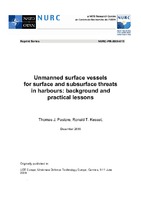Unmanned surface vessels for surface and subsurface threats in harbours: background and practical lessons

Abstract
The use of Unmanned Surface Vehicles (USVs) in harbour protection missions has been studied through technology surveys and experimentation within the programme of work at NURC. The crucial subsystems and vehicle payloads which provide a vessel's capability were assessed. The mission of harbour protection can be broken down into representative subtasks, and possible application of USVs to each is discussed. The important conclusions of the earlier work can be summarized as follows: - The potential benefit of USVs ranks with that of other classes of unmanned systems - reduced life-cycle cost, personnel safety through increased standoff distance, and reliable performance of tedious repetitive tasks (not subject to operator fatigue). - A productive overlap exists between the USV community and other classes of unmanned systems. -- The USV market is mature: there are numerous vessels with semiautonomous control systems available commercially. - Several universities and laboratories worldwide are conducting important research into autonomy as related to USVs. - Most, if not all, commercially available USVs lack sufficient autonomy to be of immediate use in a harbour protection role. In fact, their reliability concerns and uncertain legal status could render them liabilities in the close confines of a harbour environment. - The necessary advances in autonomy depend in part on close integration of the onboard sensors and the onboard decision making tools. At-sea experimentation begun in 2007 and continuing through 2009 has provided practical lessons on the use of USVs and further refinement of the "state of the art" or "state of the practice"?. This experimentation has focused on a subset of the missions and shortcomings previously identified - particularly the missions which require seamless integration of surveillance plus response against underwater threats such as divers, mines, or IEDs on the bottom or in the water column of a harbour environment. Results and analysis derived from these experiments are used to plot the course for future trends in practical operational use of USVs.
Report Number
NURC-PR-2009-015Source
Originally published in: UDT Europe, Undersea Defence Technology Europe, Cannes, 9-11 June 2009.Date
2009/12Author(s)
Pastore, Thomas J.
; Kessel, Ronald T.